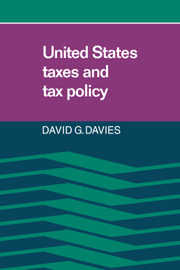Book contents
- Frontmatter
- Contents
- Preface
- 1 Economic foundations of U.S. tax policy
- 2 The individual income tax
- 3 Economic effects of individual income taxes and inflation
- 4 Expenditure versus income taxation
- 5 The taxation of capital gains
- 6 The corporation income tax
- 7 The corporation income tax and inflation
- 8 Social security payroll taxes
- 9 The value added tax
- 10 The sales tax
- 11 State taxes
- 12 Local government taxes
- 13 The distribution of tax burdens
- 14 Status of U.S. taxes and policy
- Appendix
- References
- Index
2 - The individual income tax
Published online by Cambridge University Press: 05 May 2010
- Frontmatter
- Contents
- Preface
- 1 Economic foundations of U.S. tax policy
- 2 The individual income tax
- 3 Economic effects of individual income taxes and inflation
- 4 Expenditure versus income taxation
- 5 The taxation of capital gains
- 6 The corporation income tax
- 7 The corporation income tax and inflation
- 8 Social security payroll taxes
- 9 The value added tax
- 10 The sales tax
- 11 State taxes
- 12 Local government taxes
- 13 The distribution of tax burdens
- 14 Status of U.S. taxes and policy
- Appendix
- References
- Index
Summary
Historical background
The fascinating early history of the U.S. income tax centered on three main factors:
budgetary deficits and surpluses;
the redistribution of income;
the question of direct versus indirect taxation.
Each of these issues proved to be important forces in the final and permanent adoption of the individual income tax.
Budgetary deficits and surpluses
In many instances throughout history, war proved to be an important factor in revolutionizing the fiscal system of a country. The Civil War was no exception. Tariffs, which had been the principal form of federal taxation until 1861, proved to be an inadequate revenue source for a government struggling with seceding southern states (Paul 1954:7).
A rather vague revenue law passed by Congress in 1861 committed the North to the use of an income tax. It was strengthened in 1862 when the levy was made mildly progressive, and provisions for withholding taxes at the source, including interest and dividends, were instituted (Paul 1954:7; Groves 1964:162–4).
After the usual administrative difficulties associated with introducing a new levy, the income tax proved to be a substantial source of revenue. Because funds were needed to prosecute the war, rates were increased and made more progressive in 1864. During the postwar period, Congress increased the personal exemption, made the tax proportional, and twice reduced rates. Nevertheless, large budgetary surpluses emerged, exercising a strong fiscal drag on economic activity (Olson 1973:8; Paul 1954:12–13).
- Type
- Chapter
- Information
- United States Taxes and Tax Policy , pp. 21 - 46Publisher: Cambridge University PressPrint publication year: 1986



